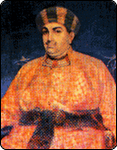Awadh Rulers
Saadat Ali Khan (1798-1814)
 Yamin-ud-daula-Nawab Saadat Ali Khan was the son of Asaf-ud-daula. Saadat-Ali-Khan was crowned on 21stJan., 1798 at a grand darbar held at Bibiyapur Palace, by Sir John Shore. As a mark of gratitude he ceded half of Awadh Kingdom to the British in 1801.
Yamin-ud-daula-Nawab Saadat Ali Khan was the son of Asaf-ud-daula. Saadat-Ali-Khan was crowned on 21stJan., 1798 at a grand darbar held at Bibiyapur Palace, by Sir John Shore. As a mark of gratitude he ceded half of Awadh Kingdom to the British in 1801.
Saadat Ali Khan, though economical in fiscal management, was nevertheless an enthusiastic builder and commissioned many grand palaces, including Dilkusha, Hayat Baksh Kothi and Farhat Buksh Kothi as well as the famous Lal -Baradari. The Farhat Buksh was purchased from Claude Martin for fifty thousand rupees. Farhat Buksh was a vast complex of buildings. It remained the chief royal residence until Wajid Ali Shah built Kaiserbagh.
The area was the scene of bitter fighting during 1857 and the complex was almost destroyed. Chattar Manzil became a British club during the period of the Raj. Since 1947 it has been housing the Central Drug Research Institute. The Royal Court at Lal Baradari, the part of Farhat Baksh Complex known as 'Qasr-uI- Sultan', the King's Palace, served as throne room, coronation hall of assembly for Awadh rulers, from the time of Saadat Ali Khan. Ghazi-ud-din-Haider was crowned in this royal Palace in 1819. The Kothi 'Dil Aaram,' was constructed on the high river bank as a private house for the Nawab. In addition to these houses the Nawab constructed the celebrated buildings Munavar Baksh, Khurshid Manzil and the Chaupar Stables. The Awadh style was gradually abandoned during reign of Saadat Ali Khan and European innovations adopted largely. The result was that Lucknow became rendezvous for more distinguished people than ever before.
In 1814 Nawab Saadat Ali Khan departed from life and was buried at his tomb with his wife 'Khursheed Zadi' in the twin Tombs of Qaiserbagh adjoining the begum Hazrat Mahal park.
Comments

